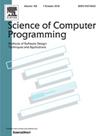Model-based testing of asynchronously communicating distributed controllers using validated mappings to formal representations
IF 1.4
4区 计算机科学
Q3 COMPUTER SCIENCE, SOFTWARE ENGINEERING
引用次数: 0
Abstract
Programmable controllers are gaining prevalence even in distributed safety-critical applications, e.g., in the railway and aerospace industries. In general, such systems are integrated using various loosely-coupled reactive components and must satisfy critical requirements. Thus, the verification of the design models and systematic testing of the implementation are essential tasks, which can be encumbered by the systems' distributed characteristics. In addition, the correctness of these verification methods is also vital. This paper, on the one hand, presents a model-based integration test generation (MBT) approach leveraging hidden formal methods based on the collaborating statechart models of the components. Statecharts can be integrated using various composition modes (e.g., synchronous and asynchronous) and then automatically mapped (via a symbolic transition systems formalism – XSTS) into the input formalisms of model checker back-ends, namely UPPAAL, Theta, Spin and nuXmv. The model checkers are utilized to generate tests based on formalized properties adhering to multiple coverage criteria. Furthermore, the paper presents a complementing validation approach for the proposed MBT approach based on demonstrating the semantic equivalence of high-level design models and the derived formal models used by the integrated model checkers for verification and test generation. The approaches are implemented in our open source Gamma Statechart Composition Framework and evaluated on industrial-scale distributed controller subsystems from the railway industry.
使用正式表示的有效映射对异步通信分布式控制器进行基于模型的测试
可编程控制器甚至在分布式安全关键应用中也越来越流行,例如在铁路和航空航天工业中。通常,这样的系统使用各种松耦合的反应性组件集成,并且必须满足关键要求。因此,设计模型的验证和实现的系统测试是必不可少的任务,这可能会受到系统分布式特性的阻碍。此外,这些验证方法的正确性也至关重要。一方面,本文提出了一种基于模型的集成测试生成(MBT)方法,该方法利用了基于组件协作状态图模型的隐藏形式化方法。Statecharts可以使用各种组合模式(例如,同步和异步)集成,然后自动映射(通过符号转换系统形式- XSTS)到模型检查器后端的输入形式,即UPPAAL, Theta, Spin和nuXmv。模型检查器用于根据遵循多个覆盖标准的形式化属性生成测试。此外,本文还提出了一种补充MBT方法的验证方法,该方法基于证明高级设计模型与集成模型检查器用于验证和测试生成的派生形式模型的语义等价性。这些方法在我们的开源Gamma状态图组合框架中实现,并在铁路行业的工业规模分布式控制器子系统上进行了评估。
本文章由计算机程序翻译,如有差异,请以英文原文为准。
求助全文
约1分钟内获得全文
求助全文
来源期刊

Science of Computer Programming
工程技术-计算机:软件工程
CiteScore
3.80
自引率
0.00%
发文量
76
审稿时长
67 days
期刊介绍:
Science of Computer Programming is dedicated to the distribution of research results in the areas of software systems development, use and maintenance, including the software aspects of hardware design.
The journal has a wide scope ranging from the many facets of methodological foundations to the details of technical issues andthe aspects of industrial practice.
The subjects of interest to SCP cover the entire spectrum of methods for the entire life cycle of software systems, including
• Requirements, specification, design, validation, verification, coding, testing, maintenance, metrics and renovation of software;
• Design, implementation and evaluation of programming languages;
• Programming environments, development tools, visualisation and animation;
• Management of the development process;
• Human factors in software, software for social interaction, software for social computing;
• Cyber physical systems, and software for the interaction between the physical and the machine;
• Software aspects of infrastructure services, system administration, and network management.
 求助内容:
求助内容: 应助结果提醒方式:
应助结果提醒方式:


